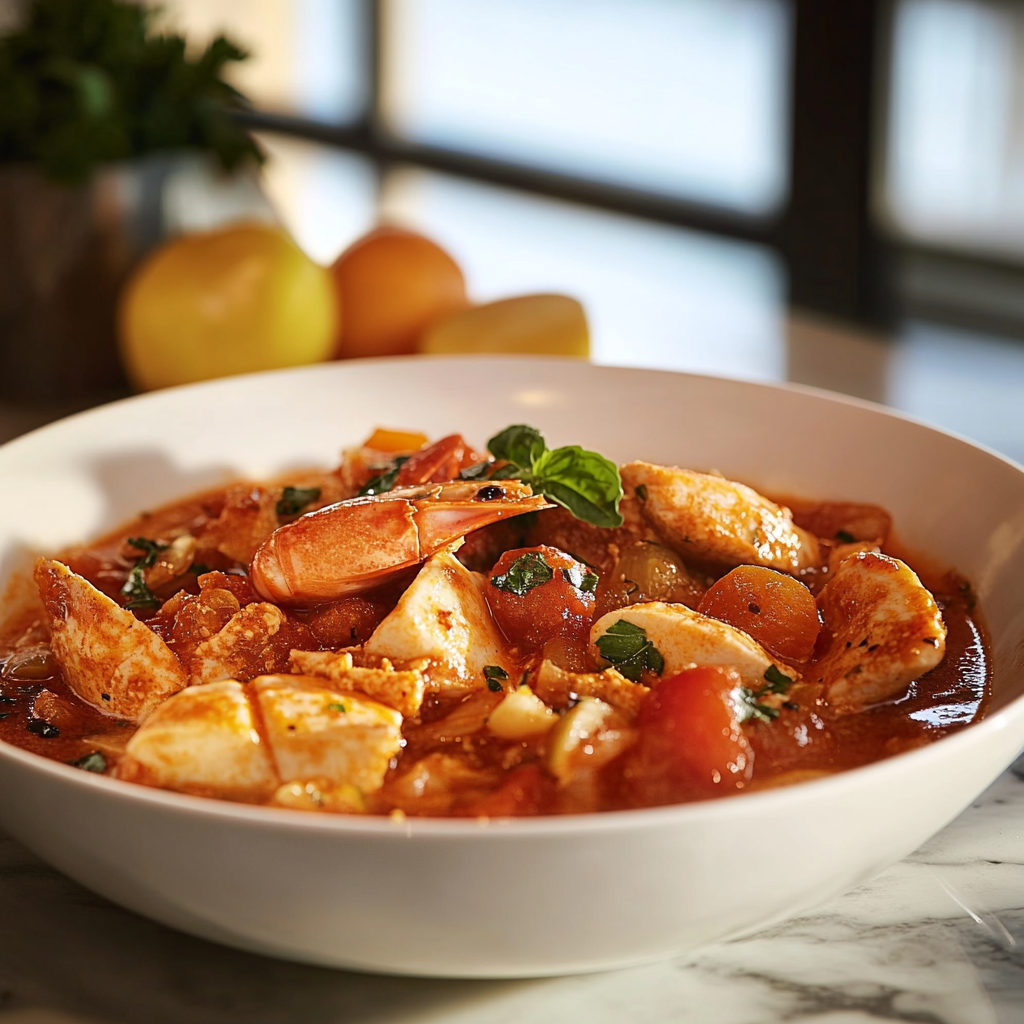Quick Overview
Cioppino is a classic Italian-American seafood stew that originated in San Francisco. Bursting with flavor and loaded with fresh seafood, this dish offers a taste of the ocean in every bite. Perfect for gatherings or cozy family dinners, cioppino combines a variety of ingredients that create a rich broth infused with tomatoes and herbs. Whether you’re an experienced cook or just starting out, this recipe makes it easy to create a gourmet meal at home.
The beauty of cioppino lies in its versatility; you can customize the seafood according to your preferences or what’s available at your local market. This dish is not only delicious but also visually appealing with its vibrant colors and textures. In just a few steps, you can prepare a hearty meal that will impress your guests. Let’s dive into the ingredient breakdown and get started on this mouthwatering seafood stew.
Ingredient Breakdown
– **Olive Oil (1/4 cup): ** This high-quality oil adds richness and depth to the broth while helping to sauté the vegetables.
– **Garlic (4 cloves, minced): ** Fresh garlic enhances the overall flavor profile of the cioppino, providing aromatic notes.
– **Onion (1 large, diced): ** Sweet onion gives sweetness and texture; it forms the base when sautéed with garlic.
– **Celery (2 stalks, chopped): ** Celery adds crunch and freshness; it complements other flavors while contributing to the stew’s overall balance.
– **Bell Pepper (1 medium, diced): ** This vegetable brings color and sweetness; use red or yellow for extra vibrancy.
– **Crushed Tomatoes (28 oz can): ** The heart of the broth; crushed tomatoes provide acidity and body while enriching the flavor.
– **White Wine (1 cup): ** A dry white wine enhances depth while helping to deglaze the pot for maximum flavor extraction.
– **Fish Stock (2 cups): ** Fish stock serves as a flavorful base; it enriches the broth without overpowering other ingredients.
– **Mixed Seafood (1 lb total): ** Use shrimp, clams, mussels, and fish fillets for variety in texture and taste—freshness is key!
– **Italian Seasoning (2 teaspoons): ** A blend of herbs enhances flavor; it typically includes basil, oregano, thyme, and rosemary.
– **Red Pepper Flakes (1 teaspoon): ** For those who enjoy heat; adjust according to personal preference.
– **Salt and Pepper (to taste): ** Essential seasonings that help balance all flavors.
Step By Step Recipe: Cioppino
1. Heat olive oil in a large pot over medium heat. Add diced onions and sauté until translucent. Stir in minced garlic and chopped celery; cook until fragrant.
2. Add diced bell pepper to the pot and continue cooking for 3–4 minutes until softened. Pour in white wine while scraping any brown bits from the bottom of the pan for extra flavor.
3. Stir in crushed tomatoes along with their juice followed by fish stock. Bring everything to a gentle simmer over medium-high heat.
4. Add Italian seasoning and red pepper flakes into the pot; season with salt and pepper according to taste. Allow it to simmer for about 10 minutes so flavors meld together beautifully.
5. Gently add mixed seafood into the pot starting with clams or mussels first since they take longer to cook; cover tightly and cook until they start opening up.
6. Once clams or mussels open up, add shrimp and fish fillets into the pot; cover again tightly until shrimp are pink and cooked through—about 5 minutes more.
7. Taste for seasoning one last time before removing from heat; adjust as necessary if desired—serve hot!

Serving and Storing Tips
Serving Suggestions
Serve your cioppino steaming hot in bowls garnished with freshly chopped parsley or basil for an aromatic touch. Pair this delightful stew with crusty bread or garlic bread on the side to soak up every drop of flavorful broth! Additionally, consider offering lemon wedges on the side as they can brighten up each bite with a refreshing zing.
Storing Instructions
If you have leftovers after enjoying your cioppino feast, store them properly! Allow the stew to cool completely before transferring it into an airtight container. It can be refrigerated for up to 3 days or frozen for up to 2 months—just make sure to thaw overnight in the fridge before reheating gently on low heat.
Enjoy this vibrant dish that captures all of summer’s best flavors right in your kitchen!
Mistakes to avoid
One common mistake when making cioppino is overcooking the seafood. Seafood cooks quickly, and overcooking can lead to tough, rubbery textures. To avoid this, add the seafood to the pot in stages based on cooking times. For instance, clams and mussels take longer to cook than shrimp or fish. Monitor the cooking process closely and remove the seafood as soon as it becomes opaque.
Another mistake is using low-quality ingredients. The flavor of cioppino heavily relies on fresh seafood and high-quality stock. Avoid using frozen seafood that has been thawed multiple times or low-grade canned tomatoes. Instead, opt for fresh, sustainable seafood and a homemade or premium store-bought broth to ensure depth of flavor in your dish.
Additionally, many people neglect seasoning during cooking. Cioppino requires a careful balance of spices and herbs to achieve its signature taste. Start by seasoning your base with salt and pepper early on, then adjust as needed throughout the cooking process. Taste frequently to ensure your flavors develop properly.
Lastly, failing to allow the flavors to meld can ruin your cioppino. After cooking, let your dish sit for a few minutes before serving. This resting period allows the flavors to combine beautifully, enhancing the overall taste experience. Don’t rush this step; good food takes time!

Tips and tricks
When preparing cioppino, always begin with a robust base of aromatics like onions, garlic, and bell peppers. Sauté these ingredients until they become fragrant before adding liquids such as broth or wine. This initial step builds a flavorful foundation that will permeate every bite of your cioppino.
Consider incorporating a variety of seafood types for complexity in flavor and texture. While traditional cioppino often features fish, clams, mussels, and shrimp, feel free to experiment with squid or crab for added richness. Each type brings its unique taste profile that enhances the overall dish.
Another useful tip is to serve cioppino with crusty bread or over pasta. This not only adds substance but also provides a wonderful way to soak up the rich sauce created from tomatoes and seafood juices. Choose a baguette or sourdough for optimal pairing.
For an extra layer of flavor, try adding a splash of white wine or brandy during cooking. Alcohol helps release aromatic compounds in the seafood while elevating the dish’s complexity. Make sure to let it simmer long enough for alcohol content to evaporate before serving.
Don’t forget about garnishing! Fresh herbs like parsley or basil sprinkled on top just before serving can brighten up your dish visually and enhance its taste profile significantly. A squeeze of lemon juice can also elevate flavors further by adding acidity.
Lastly, remember that cioppino tastes even better the next day! If you prepare it in advance, store leftovers in an airtight container in the fridge after cooling down completely. Reheat gently on low heat when you’re ready to enjoy it again.
Suggestions for Cioppino
When making cioppino at home, consider using seasonal seafood available in your area for optimal freshness and flavor. Visiting local fish markets can yield surprisingly good finds that enhance your dish’s quality while supporting local fisheries.
Another suggestion is experimenting with different broths like vegetable or lobster stock instead of traditional fish broth. These alternatives can impart unique flavors that set your cioppino apart from others while still maintaining its essence.
If you’re looking for a spicier kick, add red pepper flakes or diced jalapeños during cooking—this will give your cioppino warmth without overpowering other flavors present in the dish.
For those who prefer creamier textures, consider stirring in some heavy cream just before serving; this addition will create a richer sauce that complements the seafood beautifully without overshadowing its natural tastes.
Finally, if you have dietary restrictions or preferences like gluten-free eating habits, serve your cioppino over rice instead of traditional pasta or bread options—this way everyone can enjoy this delightful meal!

FAQs
What is Cioppino?
Cioppino is an Italian-American seafood stew originating from San Francisco’s Italian immigrant community. It typically features various types of fish and shellfish cooked in a tomato-based broth flavored with garlic, herbs, and often wine or brandy. The combination creates a rich flavor profile perfect for savoring with crusty bread.
Can I use frozen seafood for Cioppino?
Yes! You can use frozen seafood if fresh options are unavailable; however, it’s essential to thaw them properly before cooking to ensure even heating throughout your stew. When selecting frozen options at stores, look for sustainably sourced products without preservatives for best results.
How long does Cioppino last in the fridge?
Cioppino generally lasts about three days when stored correctly in an airtight container within your refrigerator after cooling completely post-cooking. It’s safe beyond this timeframe but may start losing quality regarding texture and flavor as time passes.
Can I make Cioppino ahead of time?
Absolutely! Making cioppino ahead allows flavors to meld together beautifully—just remember not to add delicate seafood until shortly before serving if preparing parts ahead so they don’t become overcooked when reheated later on!
What should I serve with Cioppino?
Cioppino pairs well with crusty bread or garlic toast for dipping into its flavorful broth; alternatively, serve over pasta or rice depending on preference! A light green salad also complements this hearty stew nicely by providing freshness against rich flavors.
Is there a vegetarian version of Cioppino?
While traditional cioppino features several types of seafood as its main ingredient source creating depth within flavor profiles naturally found therein—a vegetarian variation could replace sea-based proteins using hearty vegetables like mushrooms combined alongside beans providing protein sources instead!
Summary
In summary, making delicious cioppino involves avoiding common mistakes such as overcooking seafood and using low-quality ingredients while incorporating thoughtful tips like utilizing seasonal catches and experimenting with different broths adds richness without compromising authenticity! Remember these guidelines along with proper storage techniques will ensure you enjoy this beloved Italian-American stew any time!

